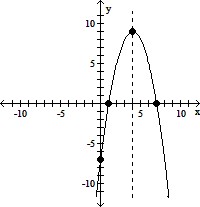Provide an appropriate response.Fill in the blanks to complete the statement. y = f(x) The equation f(x) = 0 has ____ real solution(s) and ____ imaginary solution(s).
The equation f(x) = 0 has ____ real solution(s) and ____ imaginary solution(s).
A. 2; 0
B. 0; 2
C. 0; 0
D. 1; 1
Answer: B
You might also like to view...
Evaluate the integral. dt
dt
A. -cos  + C
+ C
B. -  cos
cos  + C
+ C
C.  cos
cos  + C
+ C
D. 6 cos  + C
+ C
Graph the quadratic function using its vertex, axis of symmetry, and intercepts.f(x) = x2 + 8x + 7
A. vertex (-4, 9)
intercepts (-1, 0), (- 7, 0), (0, -7)
B. vertex (4, 9)
intercepts (1, 0), (7, 0), (0, -7)
C. vertex (-4, -9)
intercepts (-1, 0), (- 7, 0), (0, 7)
D. vertex (4, -9)
intercepts (1, 0), (7, 0), (0, 7)
Use a graphing utility to find the sum of the geometric sequence. Round answer to two decimal places, if necessary.
A. -169.75 B. -171.37 C. -170.87 D. -170.62
Solve the problem, rounding the answer as appropriate. Assume that "pure dominant" describes one who has two dominant genes for a given trait; "pure recessive" describes one who has two recessive genes for a given trait; and "hybrid" describes one who has one of each.In a population, 40% of the females are pure dominant, 50% are hybrid, and 10% are pure recessive. If a pure recessive male mates with a random female and their first offspring has the dominant trait, what is the probability that the female is hybrid?
A. .17 B. .25 C. .56 D. .50